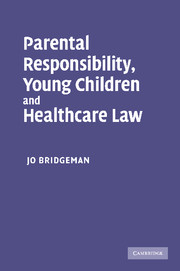Book contents
- Frontmatter
- Contents
- Acknowledgements
- Table of cases
- Table of legislation and international instruments
- 1 Parents, young children and healthcare law
- 2 Child-centred healthcare services for children
- 3 Child health and parental obligations
- 4 In the best interests of the child?
- 5 The quality of life of severely disabled children
- 6 Obligations and caring responsibilities
- 7 Relational responsibilities
- Bibliography
- Index
4 - In the best interests of the child?
Published online by Cambridge University Press: 17 July 2009
- Frontmatter
- Contents
- Acknowledgements
- Table of cases
- Table of legislation and international instruments
- 1 Parents, young children and healthcare law
- 2 Child-centred healthcare services for children
- 3 Child health and parental obligations
- 4 In the best interests of the child?
- 5 The quality of life of severely disabled children
- 6 Obligations and caring responsibilities
- 7 Relational responsibilities
- Bibliography
- Index
Summary
Introduction
As examined in the previous chapter, all parents have the legal obligation to secure treatment for everyday injuries and inevitable childhood illnesses yet some parents are confronted with a child whose medical condition presents a much more serious prognosis. Parents may have to take care of children with life-threatening conditions such as congenital heart problems, serious illnesses like leukaemia, or accidental injuries of such magnitude that without treatment they are life-threatening. Or, whilst not being life-threatening, the child's condition may mean extended dependency and require basic care, intensive nursing and therapeutic management such as is involved in the care of children with physical and mental disabilities. Parents may be required to make decisions about treatment which alters appearance, with major ramifications for a child's life. Parents of children with serious, severe or life-threatening illnesses or injuries have to navigate the healthcare system, negotiate with service providers and work in partnership with professionals with nursing and medical expertise to secure the best care for their child. In doing so, both parent and professional are confronted with uncertainty. For the professional there is uncertainty about the possibilities of medical science and the child's prognosis. For the parent there is uncertainty about their child's needs and welfare which may take them on an agonising journey through the emotions of hope, fear, worry and distress. In most cases, professionals and parents caring for a child with a serious, severe or life-threatening condition work together to determine which treatment is best for the child.
- Type
- Chapter
- Information
- Parental Responsibility, Young Children and Healthcare Law , pp. 123 - 157Publisher: Cambridge University PressPrint publication year: 2007



